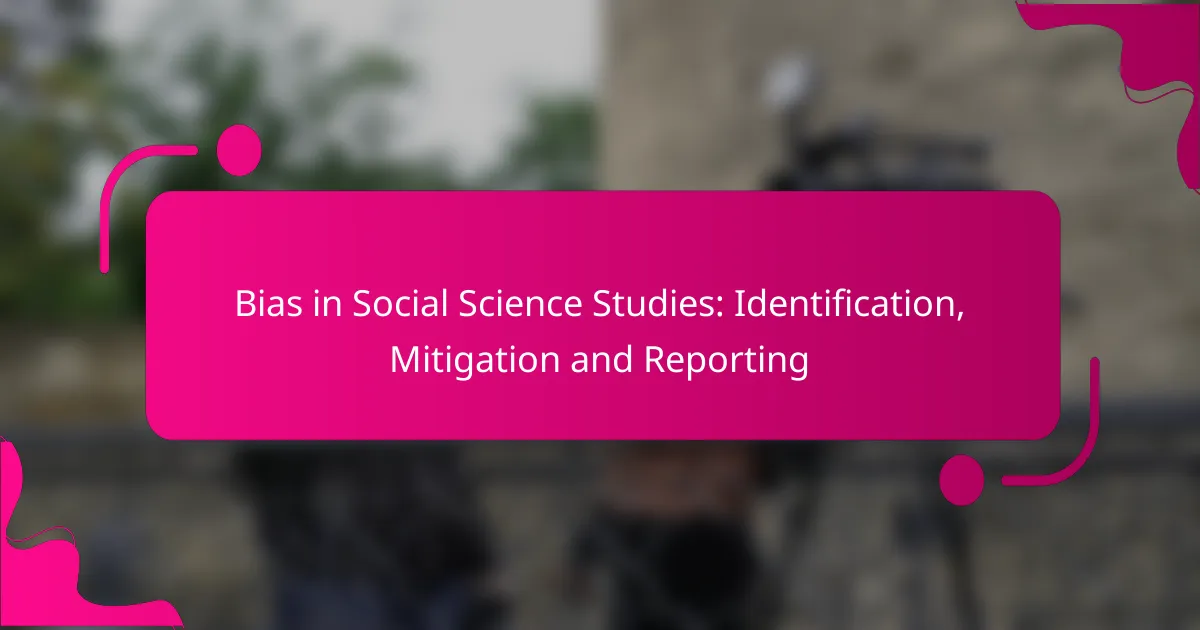Bias in social science studies poses significant challenges to the validity and reliability of research findings. Identifying and mitigating these biases through careful study design, data collection, and transparent reporting is essential for maintaining the integrity of research. By implementing systematic strategies and fostering awareness among researchers, the impact of bias can be effectively reduced, ensuring more accurate interpretations of results.
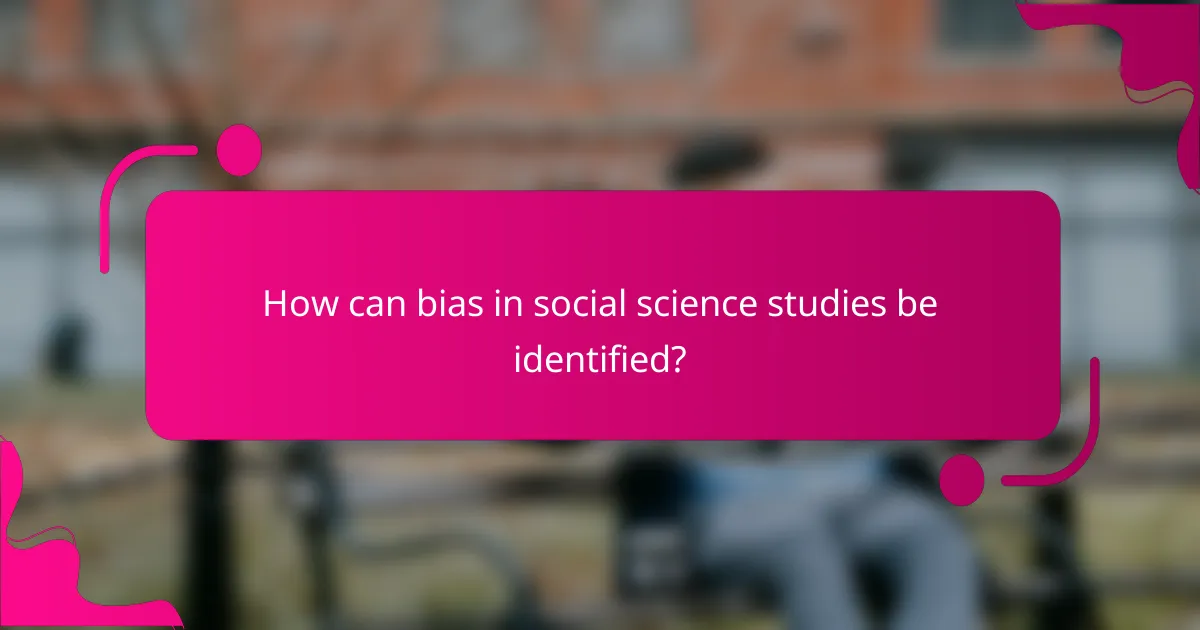
How can bias in social science studies be identified?
Bias in social science studies can be identified through careful examination of study design, data collection methods, and analysis techniques. Recognizing potential sources of bias is crucial for ensuring the validity and reliability of research findings.
Types of bias in research
There are several types of bias that can affect social science research, including selection bias, measurement bias, and confirmation bias. Selection bias occurs when the sample is not representative of the population, while measurement bias arises from inaccurate data collection tools or processes. Confirmation bias leads researchers to favor information that supports their hypotheses, potentially skewing results.
Other biases include publication bias, where studies with significant results are more likely to be published, and recall bias, which affects studies relying on participants’ memory. Understanding these biases helps researchers design better studies and interpret results more accurately.
Common indicators of bias
Indicators of bias can manifest in various ways, such as discrepancies between reported findings and raw data or a lack of transparency in methodology. If a study predominantly reports positive outcomes while neglecting negative results, this may signal publication bias.
Furthermore, if the sample size is small or the selection criteria are unclear, these factors can indicate potential bias. Researchers should scrutinize the demographics of study participants to ensure diversity and representation, which can help mitigate bias.
Statistical methods for detection
Statistical methods can effectively detect bias in social science studies. Techniques such as regression analysis can help identify relationships between variables while controlling for potential confounders. Additionally, meta-analysis can reveal publication bias through funnel plots, which visually represent the distribution of study results.
Researchers can also use sensitivity analysis to assess how different assumptions impact study outcomes. By applying these statistical methods, researchers can better understand the extent of bias and its implications for their findings.
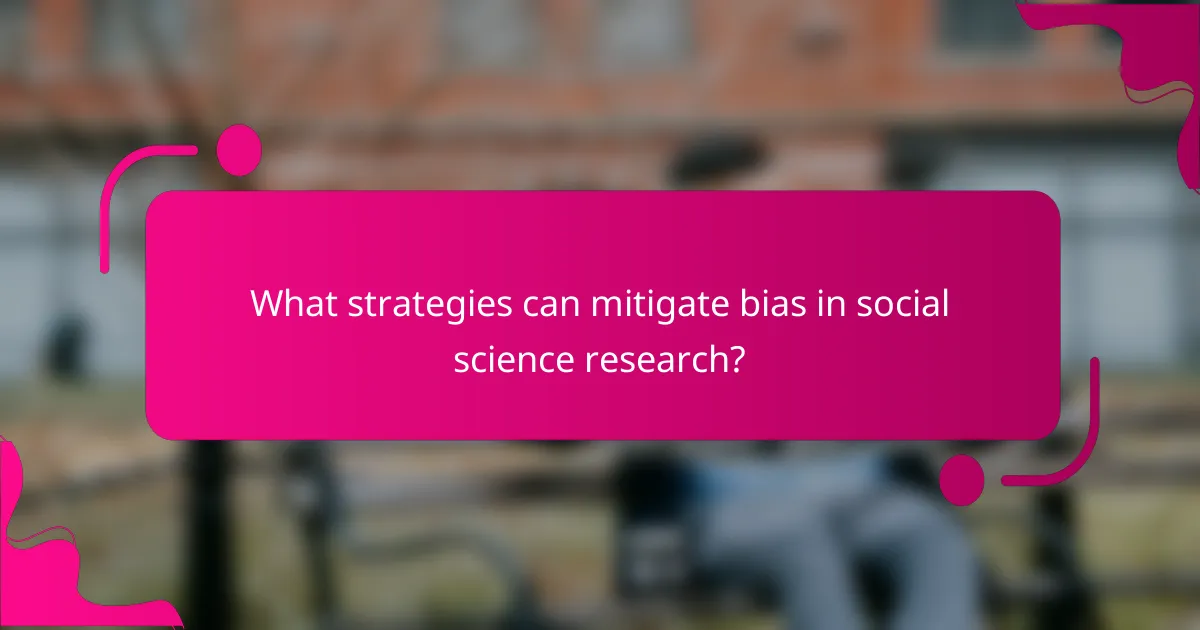
What strategies can mitigate bias in social science research?
Mitigating bias in social science research involves implementing systematic strategies throughout the research process. Key approaches include designing unbiased studies, training researchers on bias awareness, and establishing robust peer review processes.
Designing unbiased studies
To design unbiased studies, researchers should utilize random sampling techniques to ensure representative samples. This helps avoid selection bias, which can skew results. Additionally, employing control groups can provide a clearer comparison and enhance the validity of findings.
Researchers should also consider blinding participants and researchers to reduce confirmation bias. For example, in clinical trials, double-blind designs prevent both parties from knowing treatment assignments, thus minimizing expectations influencing outcomes.
Training researchers on bias awareness
Training programs focused on bias awareness are essential for researchers to recognize their own potential biases. Workshops and seminars can cover topics such as cognitive biases, cultural influences, and ethical considerations in research design.
Regular training can help researchers develop critical thinking skills and foster an environment where questioning assumptions is encouraged. This proactive approach can lead to more rigorous and objective research outcomes.
Implementing peer review processes
Establishing thorough peer review processes is crucial for identifying and addressing bias before publication. Reviewers should be trained to spot potential biases in study design, data interpretation, and reporting.
Incorporating diverse perspectives in the review process can further enhance objectivity. Engaging reviewers from various backgrounds and expertise can help ensure that different viewpoints are considered, ultimately leading to more balanced research findings.
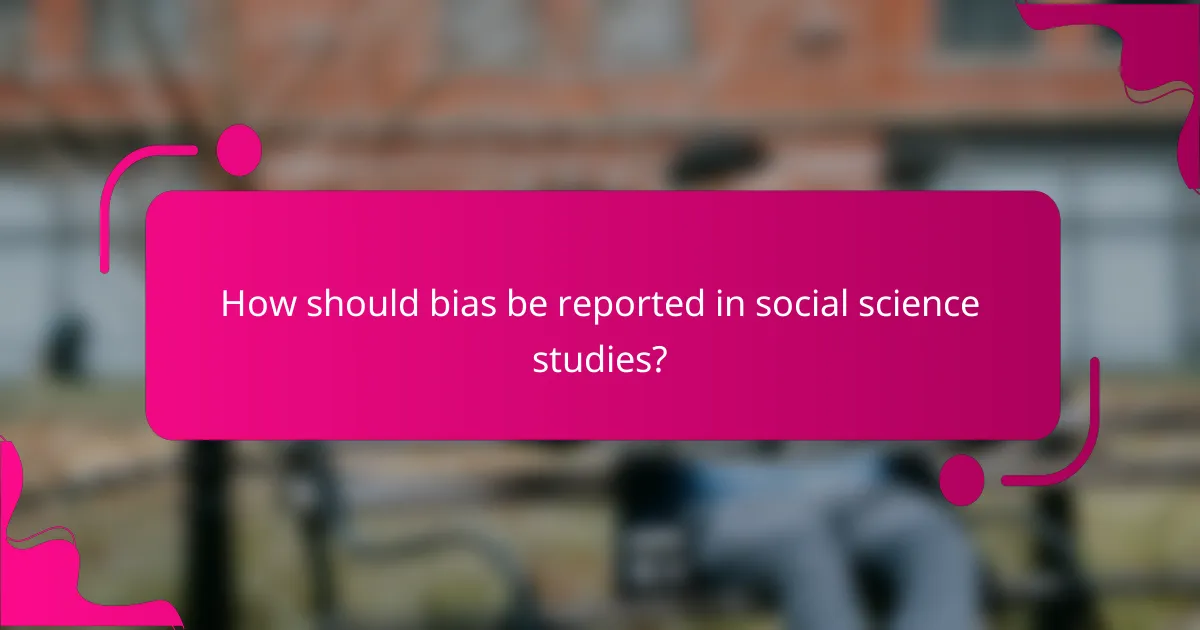
How should bias be reported in social science studies?
Bias in social science studies should be reported clearly and transparently to ensure that findings are interpreted accurately. Researchers must identify potential biases in their methodology and disclose them in their publications to maintain the integrity of their work.
Best practices for transparent reporting
To achieve transparent reporting, researchers should follow established guidelines such as the CONSORT or STROBE statements, which provide frameworks for disclosing biases. Key practices include detailing the study design, sampling methods, and data collection processes, as well as any conflicts of interest that may influence results.
Additionally, researchers should use plain language to describe biases, making it accessible to a broader audience. This includes defining technical terms and explaining how biases may affect the study’s conclusions.
Importance of disclosure statements
Disclosure statements are vital as they inform readers about potential conflicts of interest or funding sources that could introduce bias. These statements enhance the credibility of the research and allow for a more informed evaluation of the findings.
By including disclosure statements, researchers can foster trust within the academic community and among the public. This practice encourages accountability and supports the ethical standards expected in social science research.
Examples of effective bias reporting
Effective bias reporting can be seen in studies that explicitly outline limitations related to sample selection, such as convenience sampling or self-reported data. For instance, a study may note that its findings are based on a specific demographic group, which may not be representative of the general population.
Another example includes research that discusses the influence of funding sources on study outcomes. If a study is funded by an organization with vested interests, the researchers should disclose this relationship to help readers assess potential biases in the results.

What frameworks exist for evaluating bias in studies?
Several frameworks are available for evaluating bias in social science studies, focusing on identifying, assessing, and mitigating potential biases. These frameworks help researchers ensure the integrity of their findings and enhance the credibility of their work.
Frameworks for bias assessment
Frameworks for bias assessment typically include systematic approaches such as the Cochrane Risk of Bias Tool and the Newcastle-Ottawa Scale. These tools provide criteria for evaluating the risk of bias in various study designs, including randomized controlled trials and observational studies.
Researchers should consider factors like selection bias, measurement bias, and reporting bias when applying these frameworks. For instance, the Cochrane tool emphasizes the importance of randomization and blinding, while the Newcastle-Ottawa Scale focuses on the selection of study groups and the comparability of outcomes.
Guidelines from APA and other organizations
The American Psychological Association (APA) and similar organizations offer guidelines to help researchers identify and mitigate bias in their studies. The APA’s Publication Manual outlines best practices for reporting research findings, emphasizing transparency and the disclosure of potential conflicts of interest.
Additionally, organizations like the American Statistical Association (ASA) provide resources on statistical ethics and the importance of unbiased reporting. Researchers should adhere to these guidelines to enhance the reliability of their studies and foster trust within the academic community.
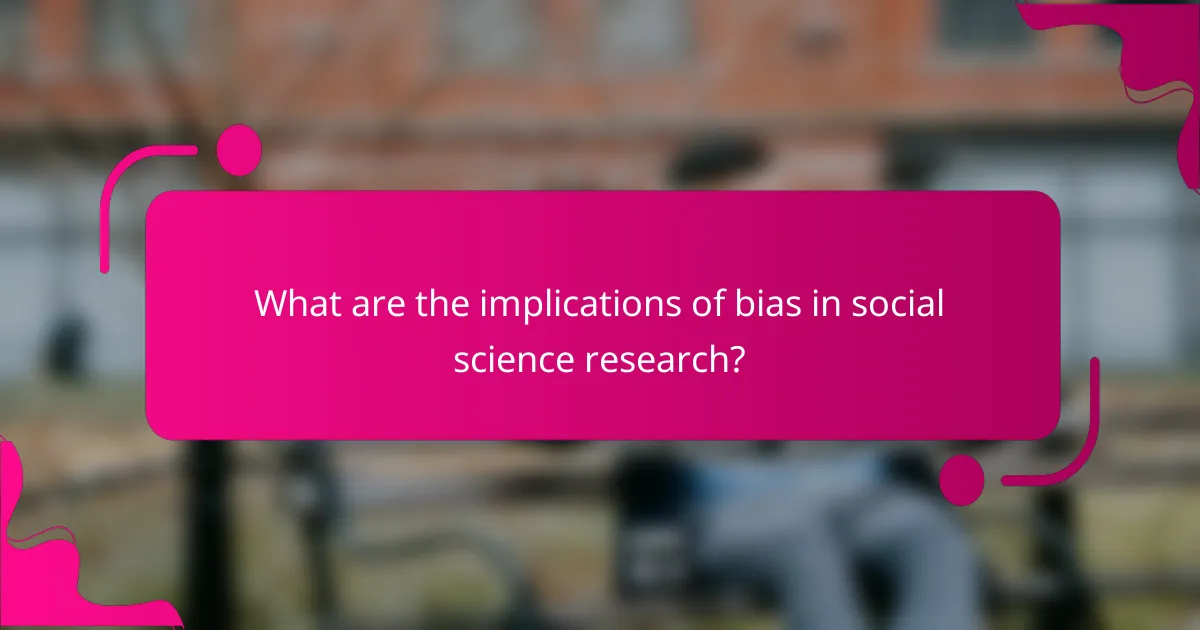
What are the implications of bias in social science research?
Bias in social science research can significantly distort findings, leading to incorrect conclusions and ineffective policies. Understanding these implications is crucial for researchers, policymakers, and the public to ensure that decisions are based on accurate and reliable data.
Impact on policy and decision-making
Bias can lead to flawed policies that do not address the actual needs of the population. For instance, if a study overrepresents certain demographics, the resulting policies may favor those groups while neglecting others, potentially exacerbating social inequalities.
Policymakers rely on research to inform their decisions. When bias skews the data, it can result in misallocation of resources, ineffective programs, and wasted taxpayer money. It is essential for researchers to disclose potential biases and for policymakers to critically evaluate the sources of their information.
Consequences for public trust in research
When biases are identified in social science studies, public trust in research can diminish. If people perceive that research is manipulated or biased, they may question the validity of findings, leading to skepticism about scientific conclusions.
Restoring trust requires transparency in research practices, including clear reporting of methodologies and potential biases. Engaging the public in discussions about research findings and their implications can also help rebuild confidence in social science research.
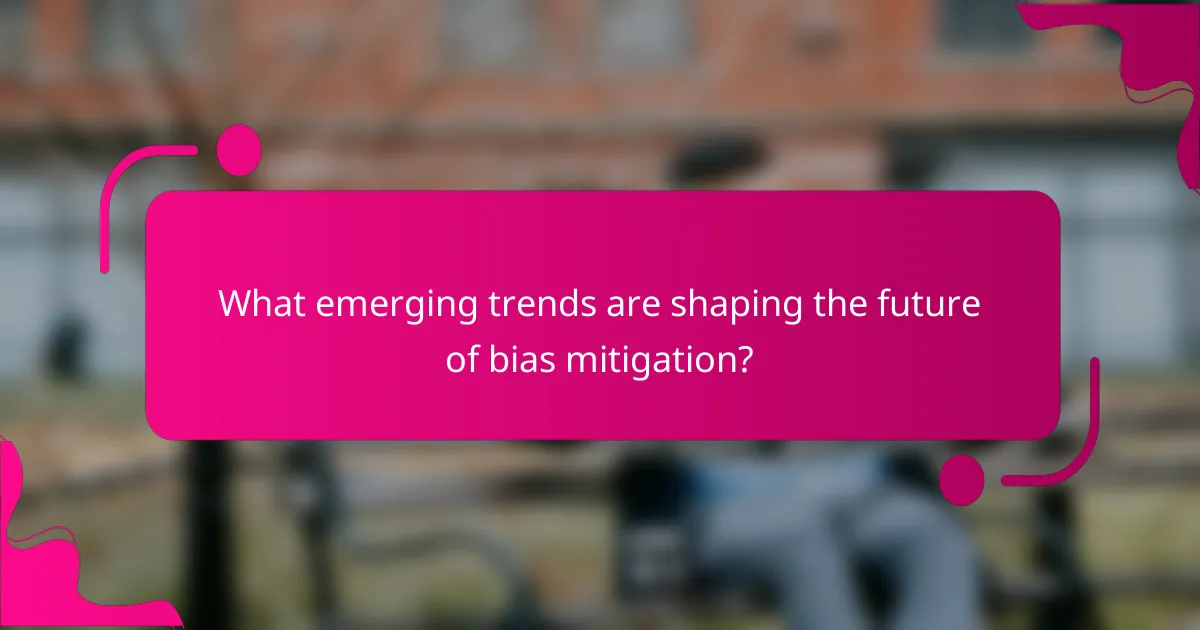
What emerging trends are shaping the future of bias mitigation?
Emerging trends in bias mitigation focus on leveraging technology, enhancing team diversity, and anticipating regulatory changes. These trends aim to create more equitable and accurate social science research by addressing inherent biases in methodologies and analyses.
Advancements in AI for bias detection
Artificial intelligence is increasingly being utilized to identify biases in social science studies. Machine learning algorithms can analyze large datasets to uncover patterns of bias that human researchers might overlook. For example, AI can assess language use in research papers to detect biased terminology or framing.
Tools such as natural language processing (NLP) are becoming essential in evaluating the objectivity of research findings. Researchers can use these technologies to refine their methodologies, ensuring that biases are minimized before publication.
Increased focus on diversity in research teams
Diverse research teams bring a variety of perspectives that can help identify and mitigate biases in studies. By including individuals from different backgrounds, researchers can challenge assumptions and broaden the scope of inquiry. This diversity can lead to more comprehensive and representative findings.
Organizations are increasingly prioritizing diversity in hiring practices, aiming for teams that reflect the demographics of the populations being studied. This approach not only enhances the quality of research but also fosters an inclusive environment that values varied viewpoints.
Future regulatory changes in research practices
Anticipated regulatory changes are likely to enforce stricter guidelines on bias mitigation in social science research. Regulatory bodies may require transparency in reporting methodologies and the inclusion of bias assessments in research proposals. These changes aim to enhance accountability and integrity in research practices.
Researchers should stay informed about evolving regulations, as compliance will become essential for funding and publication. Engaging with these changes early can provide a competitive edge and ensure that research adheres to the highest ethical standards.
